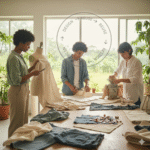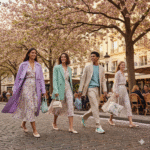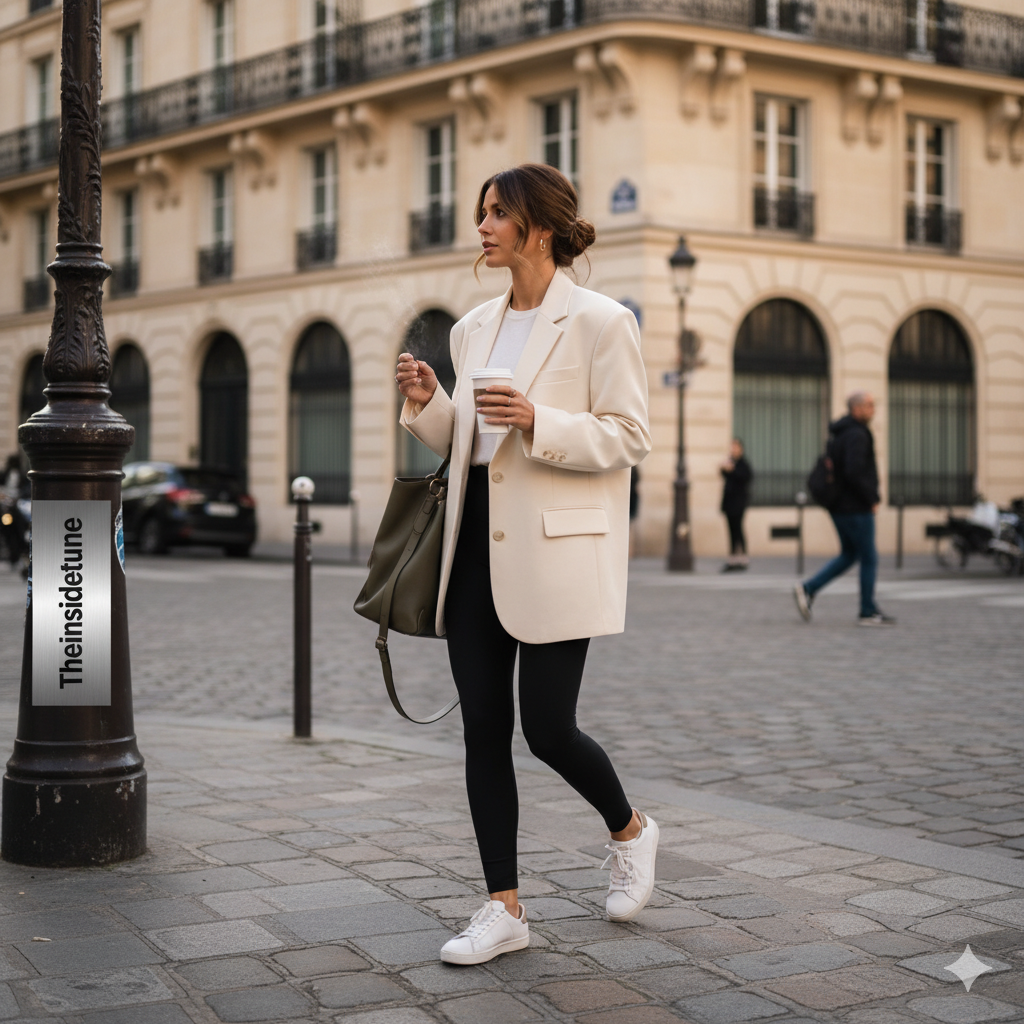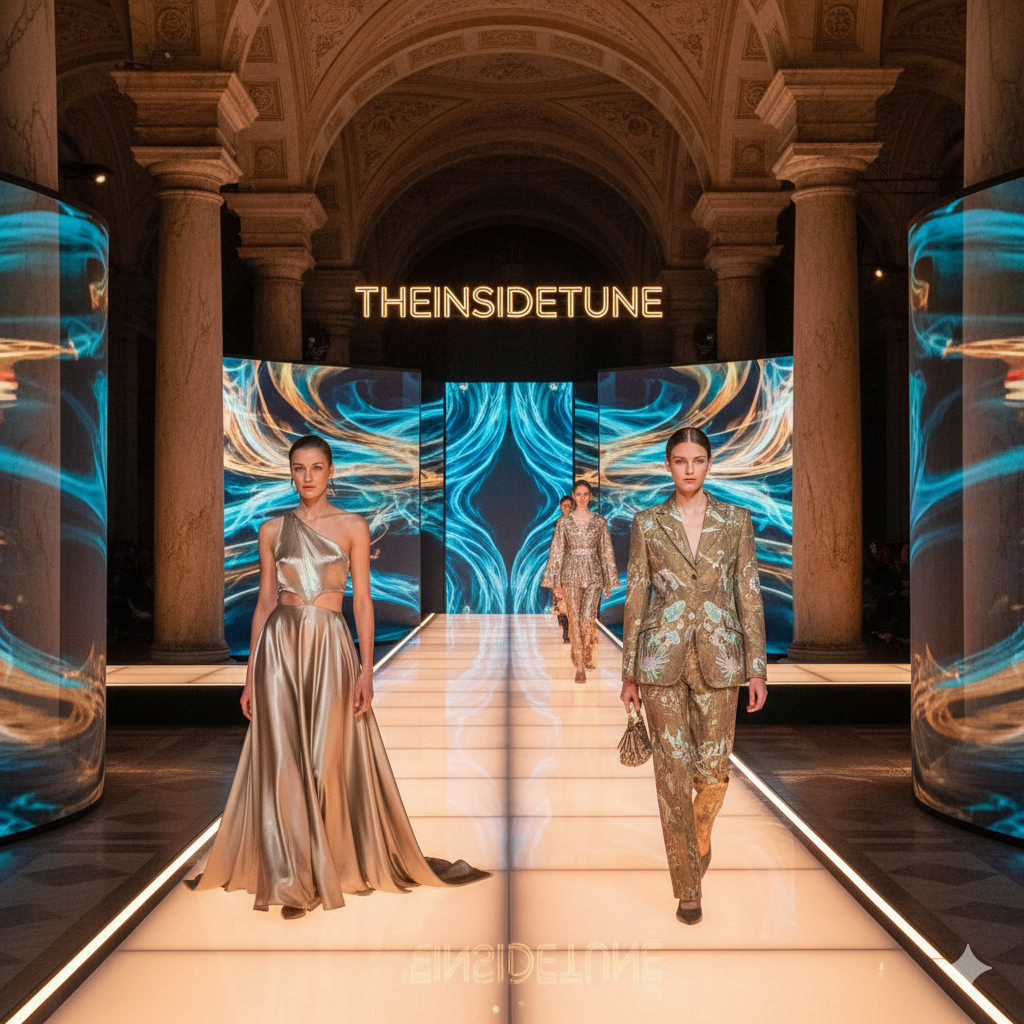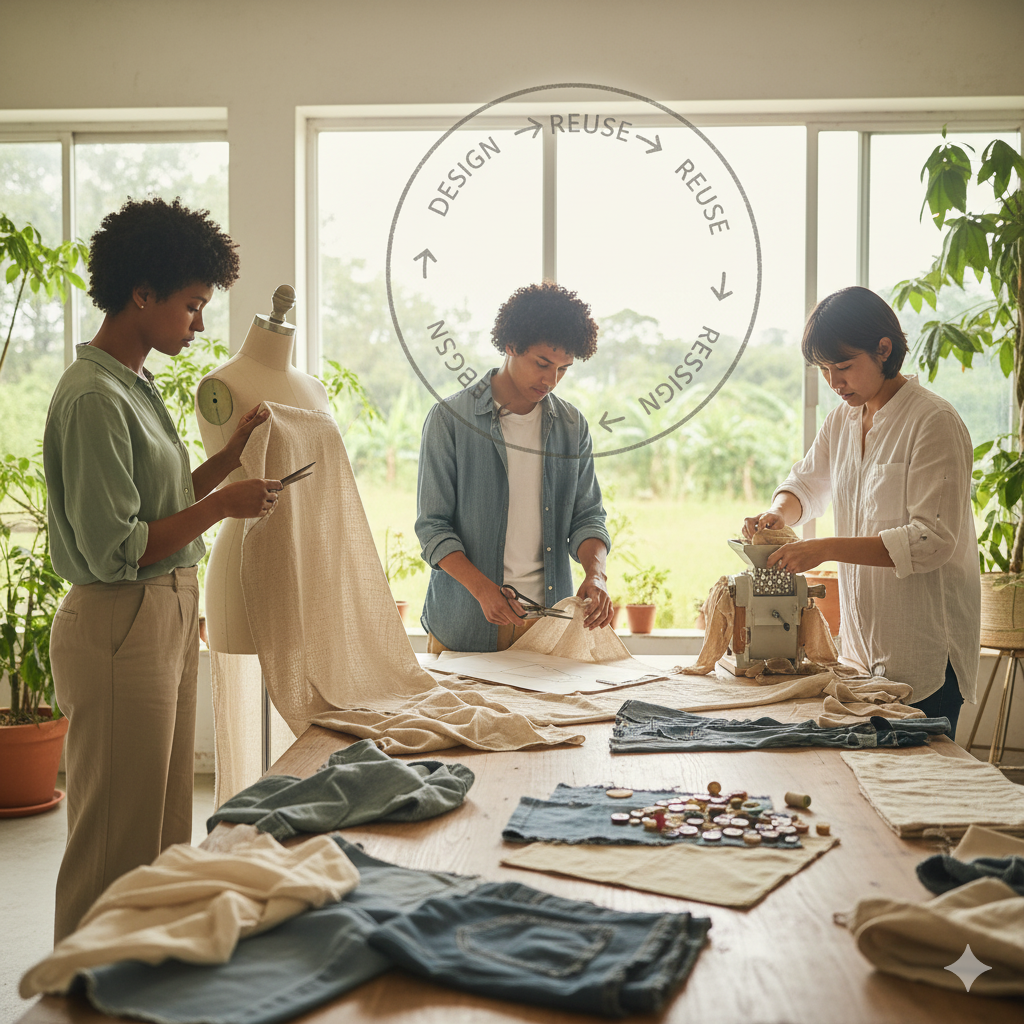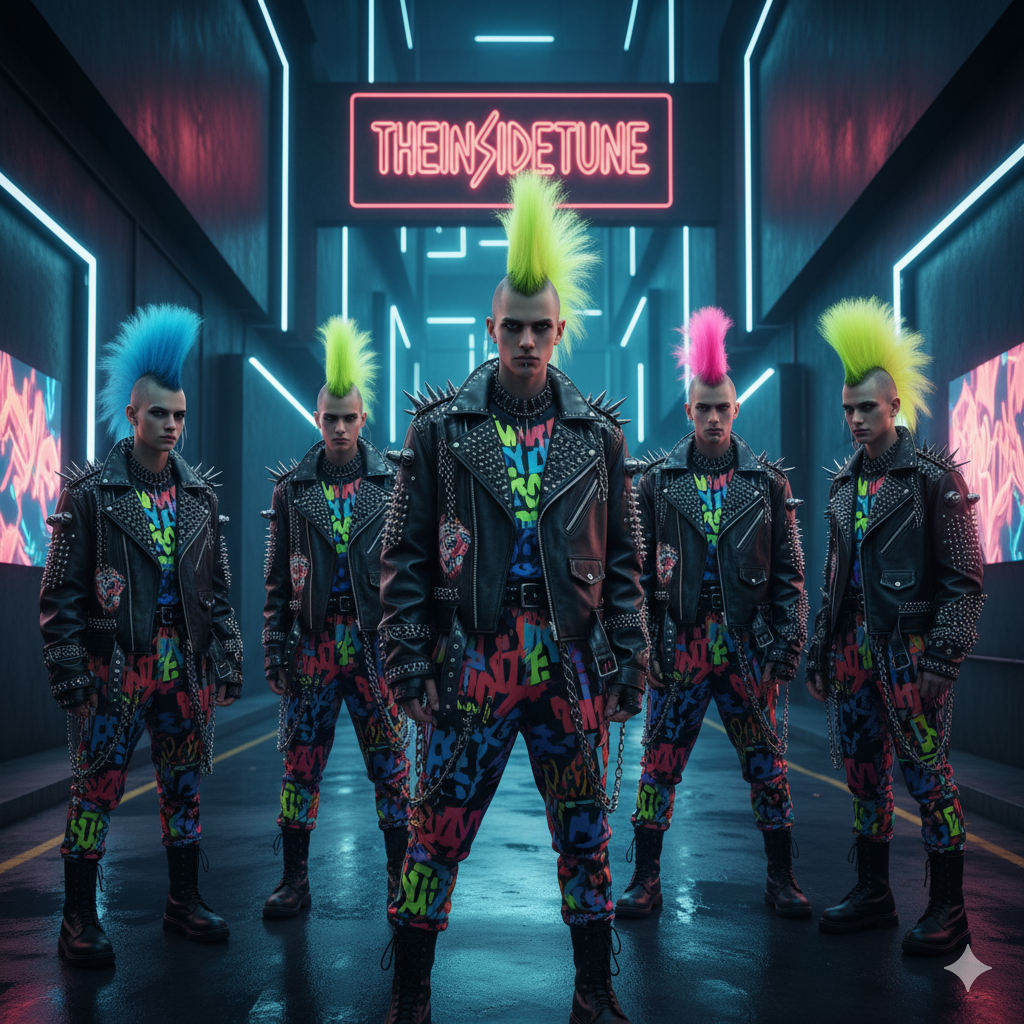Table of Contents
ToggleActivewear in Europe 2025; The Evolution and Future of Activewear: Fashion, Function, and Fitness 🏃♀️👟✨
Introduction: Why Activewear is More Than Just Gym Clothes 🧘♂️
Activewear has come a long way from the days when it was simply “something you wore to sweat in.” Today, it’s not just clothing—it’s a cultural symbol, a lifestyle choice, and one of the fastest-growing sectors in fashion. Walk down the streets of Paris, Berlin, or Copenhagen and you’ll see the proof: sleek leggings styled with trench coats, retro sneakers paired with maxi dresses, and chic sports bras layered under oversized blazers. Activewear has transformed from an afterthought to an everyday essential.
What makes this shift so powerful is that activewear represents more than fitness—it embodies modern living. In a world where people balance gym sessions, remote work, social events, and travel, clothes need to adapt seamlessly. Activewear does exactly that. It offers comfort for movement, technology for performance, and aesthetics that rival high fashion. In many ways, it’s a mirror of today’s priorities: wellness, flexibility, and self-expression.
Europe, in particular, has been at the heart of this transformation. From Adidas’s global influence out of Germany, to Stella McCartney redefining high-fashion collaborations in London, to the minimal Scandinavian approach that emphasizes sustainability and design—Europe’s fashion capitals have shaped the global conversation about activewear.
But how did we get here? And where is this rapidly growing fashion category heading? Let’s take a journey through the evolution of activewear, explore why it works so well, uncover its sustainability revolution, and peek into its exciting future.
A Quick Look Back: The Evolution of Activewear Through the Decades ⏳
The story of activewear is as dynamic as the clothes themselves. Each era reflects not just design trends, but the cultural, social, and technological shifts of the time.
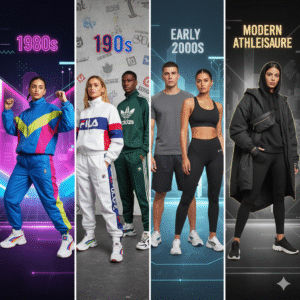
The 1980s & 1990s: Energy, Logos, and Lifestyle
The fitness craze of the 1980s was fueled by aerobics videos, celebrity workout tapes, and brightly lit gyms. This was the age of neon spandex, bold leotards, and—you guessed it—leg warmers. But it was also the birth of activewear as a fashion statement. People didn’t just wear these clothes to work out; they wore them in public, to the shops, or for casual hangouts.
The 1990s doubled down on this idea with the rise of branded sportswear. Adidas’s three stripes, Nike’s swoosh, Puma’s jumping cat—logos were everywhere. Tracksuits became cultural icons, worn not only by athletes but also by hip-hop artists, football fans, and streetwear enthusiasts across Europe. For the first time, sports brands weren’t just outfitting the gym—they were dressing a generation.
The 2000s: Function First
The early 2000s saw a shift toward performance-driven design. Gym memberships rose, marathons gained mainstream appeal, and sports science entered the spotlight. Activewear responded with smarter fabrics: moisture-wicking, anti-odor, breathable, and stretchable. Leggings were no longer just stretchy pants—they were engineered for movement. This was also the start of collaborations between sports brands and high-fashion designers, planting the seeds of today’s athleisure trend.
The 2010s: The Athleisure Explosion
By the 2010s, activewear had taken on a life of its own. Athleisure became the buzzword, describing the fusion of athletic gear with leisurewear. Suddenly, yoga pants were brunch pants, sneakers were luxury runway staples, and hoodies were layered under couture coats. In Europe, this trend blended with city-specific aesthetics: minimalist silhouettes in Copenhagen, oversized streetwear in Berlin, and sleek monochromes in Paris.
Today: A Lifestyle, Not Just a Look
Fast forward to now, and activewear isn’t just about gym sessions—it’s about identity. It reflects values like sustainability, inclusivity, and self-expression. It caters to people who want to feel strong, stylish, and authentic in every season.
Why Activewear Works: The Perfect Blend of Functionality & Fashion ✨👚
The magic of activewear lies in its ability to blend two worlds that once seemed far apart: practical performance and high fashion. Where gym clothes were once baggy, basic, and uninspiring, today’s activewear is sleek, stylish, and even runway-worthy. But the secret to its success is that it never lost sight of its first purpose: functionality.
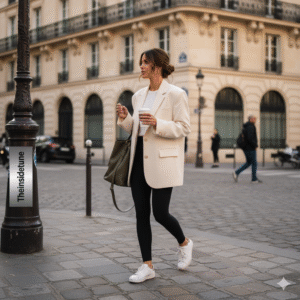
1. The Science Behind the Style 🧵⚡
Modern activewear is designed with innovation at its core. Textile technology has completely changed the game:
-
Moisture-Wicking Fabrics: These draw sweat away from the skin and dry quickly, keeping the body cool during workouts or city commutes.
-
Breathability: Mesh panels, laser-cut ventilation, and lightweight knits allow airflow where the body needs it most.
-
Four-Way Stretch: Whether you’re lunging in the gym or running for a bus, fabrics move with you without losing shape.
-
Compression Technology: Some leggings and tops are designed to improve blood circulation, reduce fatigue, and enhance recovery.
-
Seamless Construction: By minimizing seams, brands reduce chafing, irritation, and even fabric waste.
These advancements mean activewear isn’t just “clothes for exercise.” It’s engineered gear that enhances your movement—while still looking good enough to wear outside the gym.
2. Comfort Reimagined 😌
Comfort has always been the reason people reach for activewear—but comfort today comes with style upgrades. High-waisted leggings create flattering silhouettes. Sports bras double as chic crop tops. Sneakers are designed with ergonomic soles but styled in trending colorways. This evolution means activewear now delivers confidence as much as comfort.
In cities like Paris, women style leggings with longline coats and leather handbags for a casual-yet-sophisticated look. In Berlin, the vibe leans street-smart with oversized hoodies, joggers, and chunky sneakers. Meanwhile, Copenhagen’s minimalist style champions clean cuts, neutral tones, and eco-conscious fabrics. Activewear adapts to each city’s identity—proving it’s as much fashion as it is function.
3. The Style Factor 🎨👟
Activewear became a cultural phenomenon once it moved beyond the gym and onto the streets. Suddenly, sportswear wasn’t just allowed in public—it was celebrated. Brands began collaborating with fashion designers, bringing high-style details into sporty silhouettes.
-
Adidas x Stella McCartney set a new standard for luxury sportswear.
-
Nike x Off-White blurred the lines between performance gear and streetwear.
-
Puma x Rihanna (Fenty) made athleisure glamorous and edgy.
These collaborations shaped activewear into more than workout wear—it became a lifestyle uniform that could belong in a gym, a coffee shop, or even a fashion week show.
4. Activewear as Identity 🪞
Perhaps the most interesting reason activewear “works” is because it speaks to our lifestyle values.
-
It says, I value movement and wellness.
-
It signals, I care about style but also comfort.
-
It reflects, I’m part of a modern, health-conscious, and flexible culture.
In Europe, activewear is also tied to social identity. Scandinavian brands emphasize sustainability, Parisian labels highlight elegance in simplicity, and Berlin’s street culture favors rebellion and creativity. What you wear in activewear isn’t just about the gym—it’s about the story you want to tell.
5. Tips for Styling Activewear with Confidence 💡👗
If activewear is going to stay in your wardrobe rotation (and let’s be real—it is), here are some tips for rocking it like Europeans do:
-
Layer Smartly: Pair leggings or bike shorts with oversized blazers, trench coats, or knit sweaters. This balances sporty and chic.
-
Choose Elevated Sneakers: Trainers are everywhere in Europe’s fashion capitals. Go for clean white classics or bold designer collaborations.
-
Mix Textures: Match a sleek sports bra with tailored trousers, or joggers with a satin shirt. Contrast creates style.
-
Accessorize Thoughtfully: Add a leather crossbody, chunky gold hoops, or a structured tote to lift an activewear look instantly.
-
Stick to a Color Palette: Neutrals (black, beige, gray) are timeless, but don’t shy away from neon or prints if styled minimally.
✨ In short: Activewear “works” because it’s practical enough for movement, stylish enough for the streets, and versatile enough to blend into every aspect of modern life. It’s no longer about what you’re doing but about how you’re living.
Activewear and Sustainability: The Green Revolution 🌍♻️
In 2025, sustainability is no longer a fashion buzzword—it’s a responsibility. And in no sector does this feel more urgent than in activewear. Why? Because activewear is often made with synthetic fabrics like polyester and nylon that rely heavily on fossil fuels, shed microplastics into waterways, and take centuries to decompose. Add in the fact that these clothes are washed and worn frequently, and the environmental footprint becomes even larger.
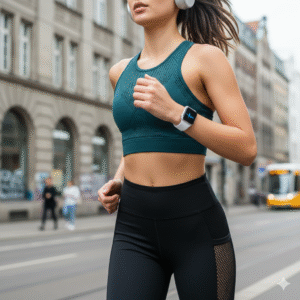
But the good news is clear: a green revolution is underway. Across Europe, sportswear and activewear brands are leading change with eco-friendly fabrics, circular design, ethical production, and consumer transparency. Today’s activewear isn’t just designed to move with you—it’s designed to respect the planet you move on.
1. Rethinking Materials: The Rise of Eco-Fabrics 🌱
The biggest sustainability shift is happening at the fabric level. Brands are investing in regenerated and bio-based textiles that reduce dependence on virgin plastics.
-
Recycled Polyester & Nylon: Many European brands now use fabrics made from post-consumer plastic bottles or discarded fishing nets. ECONYL (regenerated nylon) is a star in this space, turning waste into high-performance leggings and swimwear.
-
Plant-Based Materials: Innovations like Tencel (made from wood pulp), organic cotton, bamboo viscose, and even algae-based textiles are gaining ground. They’re breathable, biodegradable, and less resource-intensive.
-
Low-Impact Dyeing & Finishing: Waterless dye technology, natural plant dyes, and digital printing are reducing the toxic impact of traditional coloring methods.
-
Smart Sustainable Fabrics: Some new textiles even release fewer microplastics when washed or have antimicrobial properties that reduce the need for frequent laundering.
👉 Imagine a pair of leggings made from ocean plastic waste, dyed using zero-water technology, and designed to be fully recyclable at the end of its life—that’s the future Europe is actively shaping.
2. Ethical Manufacturing: Beyond the Green Label 🧵
Sustainability isn’t just about what clothes are made of—it’s also about how they’re made. European consumers increasingly demand ethical transparency.
-
Fair Wages & Safe Conditions: Brands are under pressure to ensure factory workers are paid fairly and work in safe environments, whether production is in Europe or abroad.
-
Local & Small-Batch Production: Some labels are returning manufacturing closer to home to cut transport emissions and keep supply chains accountable.
-
Certifications Matter: Labels like OEKO-TEX, Fair Trade, Bluesign, and GOTS (Global Organic Textile Standard) help consumers know which brands are truly walking the talk.
Consumers are smarter than ever—greenwashing (fake or exaggerated eco claims) is quickly called out. In fact, the EU has introduced new laws in 2024–2025 requiring brands to prove their sustainability claims with clear data, meaning the future of “eco-activewear” will be far more transparent.
3. European Leaders in Sustainable Activewear 🇪🇺
Some standout brands and initiatives from Europe are setting global benchmarks:
-
Adidas x Parley for the Oceans (Germany): Turning ocean plastic waste into sneakers and apparel.
-
Stella McCartney x Adidas (UK): Luxury collaborations with a strong sustainability ethos.
-
Pangaia (UK/Europe): Using bio-based and recycled materials in futuristic designs.
-
Reflo (UK): Creates activewear from recycled plastic, tracks how many bottles are used in each garment, and plants trees with every purchase.
-
Girlfriend Collective (popular in Europe, US-based): Though not European, it has a massive influence on eco-activewear culture across the continent with its recycled fabrics and inclusive sizing.
These brands are proving that performance, style, and sustainability can co-exist.
4. The Circular Revolution: Closing the Loop 🔄
Another major development in sustainable activewear is the shift toward circular fashion—designing clothes that can be reused, repaired, or recycled.
-
Take-Back Programs: Big brands like Nike and Adidas now offer programs where customers can return worn-out gear to be recycled into new products.
-
Rental & Resale: Platforms across Europe allow people to rent high-end activewear for events or resale lightly worn pieces, extending product life cycles.
-
Design for Longevity: Brands are focusing on durability, with stronger stitching, timeless designs, and multi-use apparel to cut down on waste.
The idea is simple: rather than clothing ending up in landfill, it should re-enter the system—whether as fabric for new leggings, insulation for buildings, or raw materials for other industries.
5. What Consumers Can Do 🌍✨
Sustainability isn’t only in the hands of brands—consumers play a huge role. Here are a few ways to make smarter choices:
-
Check Fabric Labels: Look for recycled polyester, ECONYL, or organic cotton.
-
Support Transparent Brands: Choose labels that publish their sustainability reports.
-
Buy Less, Choose Better: Invest in high-quality activewear that lasts instead of fast-fashion alternatives.
-
Care Smarter: Wash activewear in cold water, use microplastic-catching laundry bags, and air-dry to extend garment life.
-
Recycle or Donate: Don’t throw away old gear—pass it on, recycle it, or use brand take-back programs.
6. The Future of Eco-Activewear 🌐♻️
Looking ahead, sustainability in activewear will only grow stronger. Expect to see:
-
Smarter Circular Systems: Clothing that can be disassembled and remade at scale.
-
New Bio-Fabrics: Mushroom leather, lab-grown fibers, and biodegradable textiles entering mainstream sportswear.
-
EU Regulations Driving Change: Stricter rules will force all fashion brands to disclose environmental impact and carbon footprints.
-
Consumer Empowerment: Shoppers will have apps or QR codes that trace exactly where their clothes came from and how sustainable they are.
The sustainability revolution in activewear is no longer “in progress”—it’s here. And Europe is setting the pace for the rest of the world.
Activewear and Sustainability: The Green Revolution 🌍♻️
If there’s one conversation dominating the fashion industry right now, it’s sustainability. And activewear, with its heavy reliance on synthetic fabrics, fast-moving trends, and mass production, has often been at the center of the debate. But things are changing—and in a big way. Across Europe, activewear is experiencing its very own green revolution, as both brands and consumers shift toward eco-conscious choices.
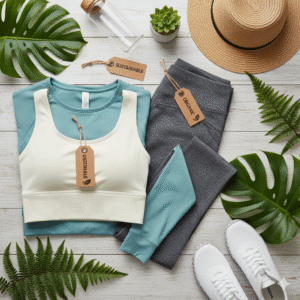
Why Sustainability Matters in Activewear 🌱
Unlike formalwear or seasonal fashion, activewear is designed to withstand movement, sweat, and frequent washing. That durability comes at a cost: most sportswear fabrics are made from petroleum-based synthetics like polyester, nylon, and elastane, which take hundreds of years to break down. Add in the global demand for new styles every season, and the environmental footprint grows significantly.
But today’s consumers—especially in Europe—are more eco-aware than ever before. They’re asking hard questions: Where was this made? Who made it? How sustainable are the fabrics? The modern buyer isn’t just looking for stylish leggings; they want pieces that align with their values.
European Brands Leading the Change 🌍👟
Europe is setting the tone for eco-friendly activewear, with brands rewriting the rules of performance fashion:
-
Adidas (Germany): Known for its Parley for the Oceans collection, Adidas uses recycled ocean plastic in sneakers and apparel, reducing marine waste while delivering high-performance gear. Their pledge to eliminate virgin polyester by 2024 is a bold step toward circularity.
-
Stella McCartney (UK): A pioneer in sustainable luxury, her collaboration with Adidas blends sleek design with eco-conscious materials. She proves sustainability can be high-fashion.
-
Pangaia (UK): Famous for bio-based fabrics and plant dyes, Pangaia has introduced seaweed fiber leggings and recycled cotton sweatshirts that are as eco-friendly as they are Instagram-worthy.
-
Veja (France): Although more lifestyle than gym, their trainers are made with organic cotton, wild rubber, and recycled plastics—perfect for pairing with athleisure outfits.
-
Ecoalf (Spain): With a motto of “Because There Is No Planet B,” Ecoalf creates activewear using upcycled materials like discarded fishing nets and plastic bottles.
These European innovators prove that performance and sustainability aren’t opposites—they’re a future-facing partnership.
The Rise of Sustainable Fabrics 🧵♻️
The materials used in activewear are undergoing a quiet revolution:
-
Recycled Polyester (rPET): Made from plastic bottles and textile waste, this reduces landfill waste while maintaining durability.
-
Econyl® Nylon: A regenerated nylon created from fishing nets and fabric scraps, used in everything from swimsuits to leggings.
-
Bamboo & Tencel: Soft, breathable, and plant-based fabrics gaining popularity in yoga wear.
-
Biodegradable Fabrics: New research in Europe is pushing for textiles that naturally decompose after use, avoiding centuries-long waste buildup.
This shift isn’t just about saving the planet—it’s about creating clothes that align with modern values.
Ethical Manufacturing: Who Made Your Clothes? 🧵🤝
Sustainability goes beyond fabrics. Activewear’s green revolution also tackles ethical manufacturing. European consumers are increasingly aware of labor rights, demanding transparency in supply chains. Certifications like Fair Trade, GOTS (Global Organic Textile Standard), and OEKO-TEX are now essential trust signals.
Many European brands proudly share stories of their production houses—often family-run factories in Portugal, Italy, or Spain—that prioritize safe conditions and fair pay. This human-centered approach makes sustainable activewear not just eco-friendly, but also socially responsible.
How Consumers Can Make Greener Choices 🌿👟
It’s not only about what brands do—consumers play a huge role too. Here are practical tips for anyone in Europe looking to shop sustainably:
-
Look for Transparency: Brands that share details about their fabrics, factories, and sourcing are usually the most trustworthy.
-
Buy Less, Choose Well: Invest in timeless, versatile activewear instead of chasing every trend.
-
Check Certifications: Labels like GOTS or OEKO-TEX guarantee eco-friendly and ethical standards.
-
Wash Smart: Use cold washes, eco-friendly detergents, and air-dry when possible. Even small changes reduce environmental impact.
-
Explore Second-Hand & Rental: Platforms like Vestiaire Collective and Vinted in Europe are making resale activewear a growing trend.
The Bigger Picture 🌍✨
The push for sustainable activewear isn’t just a fashion trend—it’s part of a cultural shift. Europe is shaping a world where what we wear reflects who we are, not only in style but also in values. The future of activewear won’t be measured solely by how breathable, flexible, or stylish it is, but also by how gently it treads on the planet.
As consumers, every purchase is a vote for the kind of world we want to live in. And as Europe leads the charge, it’s clear: the future of activewear is green, ethical, and inspiring.
The Future of Activewear: Where Fashion Meets Fitness Next 🚀✨
If the past few decades were about activewear breaking out of the gym and onto the streets, the future is about something even bigger: innovation that reshapes how we live, move, and express ourselves. Activewear is no longer just about what you wear to exercise—it’s evolving into a lifestyle uniform, a piece of technology, and even a cultural statement. The next chapter will be defined by smart fabrics, inclusivity, and the blending of fashion with function in ways we’re only beginning to imagine.

Smart Fabrics and Wearable Tech 🧵⚡
In Europe’s fashion-tech hubs like London, Berlin, and Milan, designers are experimenting with fabrics that do more than cover the body. Think:
-
Temperature-Regulating Textiles: Fabrics that adjust to body heat—keeping you warm in winter and cool during workouts.
-
Moisture-Sensing Materials: Imagine leggings that tell you when you’re dehydrated.
-
Built-in Biometric Tracking: Smart sports bras and tops with embedded sensors to track heart rate, posture, and calorie burn—no extra fitness band required.
-
Self-Healing Fabrics: Early-stage research in Germany and the Netherlands is exploring materials that “heal” micro-tears after workouts, making clothes last longer.
Soon, your activewear won’t just support your workout—it will become part of your workout, coaching you in real time.
Inclusivity and diversity; Expanding the Activewear Horizon 🌈👟
One of the most exciting shifts is greater inclusivity. The future of activewear won’t be limited to a narrow body type, gender, or lifestyle. Instead, brands are expanding their ranges to celebrate all bodies, all abilities, and all identities.
-
Extended Sizing: No more “one-size-fits-all”—European brands are embracing fuller size ranges that prioritize comfort and performance.
-
Adaptive Activewear: Clothing designed for people with disabilities is gaining traction—Velcro closures, magnetic zippers, and seamless support for those who need it.
-
Gender-Neutral Designs: Already strong in Scandinavian countries, unisex collections are making activewear about personal expression rather than labels.
The future of activewear isn’t about “fitting in”—it’s about fitting everyone.
Fashion Meets Street Culture 👟✨
European street style has always been an incubator for global fashion trends, and activewear is no exception. In the coming years, expect to see even more crossovers between luxury fashion houses and sportswear giants.
-
Paris: Chic layering of performance leggings with couture trench coats.
-
Milan: Luxury sneakers paired with high-end handbags—blurring the line between gym and runway.
-
Berlin: Bold, experimental designs inspired by subcultures, fusing graffiti art with sportswear.
-
Copenhagen: Minimalist, eco-forward styles that blend Danish design simplicity with high-performance fabrics.
As cultural movements and streetwear merge with fitness, activewear will continue to be a canvas for self-expression—not just gear.
The Work-From-Anywhere Culture 👩💻🏃♀️
In a world where home, office, and gym boundaries are blurred, activewear is becoming the uniform of modern multitaskers. Future collections are leaning toward:
-
Desk-to-Dinner Outfits: Leggings styled with blazers, sneakers with tailored trousers.
-
Travel-Friendly Fabrics: Wrinkle-resistant, lightweight pieces that transition easily from city streets to weekend getaways.
-
Hybrid Footwear: Sneakers polished enough for meetings but comfortable enough for workouts.
The future consumer doesn’t just want activewear for workouts—they want versatile designs that fit their entire lifestyle.
Sustainability at the Core 🌍♻️
Sustainability isn’t just a trend—it’s shaping the DNA of future activewear. We’ll see:
-
Circular Fashion Models: Rental activewear, take-back programs, and resale platforms.
-
Zero-Waste Design: Cutting patterns with no leftover scraps.
-
Plant-Based Performance Fabrics: Algae, mushroom leather, and hemp-based fibers making their way into leggings and sneakers.
In Europe, where eco-consciousness is a lifestyle, green innovation will become the ultimate status symbol.
The Vision Ahead 🌟
Imagine a future where your yoga pants can measure muscle fatigue, your running shoes adapt their cushioning to your stride, and your jacket changes color to reflect your mood. Sounds futuristic? Not for long. Tech labs in Sweden, Italy, and the UK are already prototyping designs that merge science with style.
The future of activewear is about empowerment—empowering individuals to feel good, move better, and express themselves boldly, while honoring the planet.
How to Rock Activewear in Europe: Style Tips and Ideas 👟👜
Activewear isn’t just about performance anymore—it’s about personality. Across Europe, it has become a wardrobe essential that easily moves from gym sessions to morning commutes, coffee dates, or even after-work socials. The beauty of activewear lies in its adaptability. But how do you make it look polished and intentional rather than “I just rolled out of the gym”? The secret lies in styling, layering, and accessorizing.
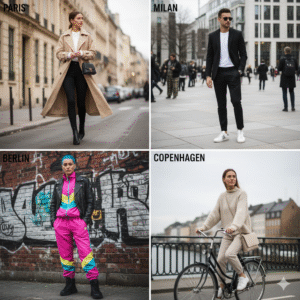
Mixing and Matching Activewear with Everyday Outfits ✨
The trick to rocking activewear lies in balance—pair sporty pieces with structured or classic items for that effortlessly cool European vibe.
-
Leggings + Oversized Blazer (Parisian Chic): Elevate basic black leggings with a longline blazer, statement sunglasses, and sleek sneakers. This look screams Paris street style.
-
Tracksuit + Leather Jacket (Berlin Edge): Layer a monochrome tracksuit under a biker jacket and pair with chunky trainers—edgy, bold, and very Berlin.
-
Sports Bra + High-Waisted Skirt (Milan Glam): Swap the usual crop top for a luxe sports bra under a satin skirt. Add strappy heels or clean white sneakers for day-to-night ease.
-
Joggers + Minimalist Knit (Copenhagen Cool): Blend cozy joggers with a soft neutral knit and sustainable sneakers. Simple, stylish, and Scandi-approved.
Mixing activewear with smart casual pieces gives you the best of both worlds—comfort + sophistication.
The Best European Cities to Spot Activewear Trends 🌍👀
Europe has its own activewear fashion map—each city has a unique take:
-
Paris: Elegant monochromes, neutral palettes, and chic layering.
-
London: Eclectic mash-ups—think bold prints, oversized hoodies, and high-top sneakers.
-
Milan: Luxury meets sport—tailored jackets paired with premium trainers.
-
Berlin: Street-inspired—oversized fits, neon pops, and graffiti-style prints.
-
Amsterdam: Effortless casual—cycling shorts with oversized shirts and sporty backpacks.
-
Copenhagen: Minimalist eco-fashion—clean lines, muted tones, and sustainable fabrics.
Travel across Europe and you’ll see how activewear reflects not just style, but local culture and lifestyle.
Accessories That Elevate Activewear 👜✨
It’s often the finishing touches that take activewear from gym kit to street-ready:
-
Sneakers: Opt for chunky “dad” sneakers for trend impact or clean white trainers for classic chic.
-
Bags: Crossbody bags, mini backpacks, and belt bags are not only practical but also complete the sporty vibe.
-
Sunglasses & Hats: Oversized sunnies, baseball caps, or bucket hats add an urban twist.
-
Jewelry: Minimalist hoops, layered chains, or statement earrings bring a touch of glam to sporty looks.
These subtle additions can turn even the most basic leggings-and-tee combo into a fashion statement.
Seasonal Tips for Activewear Layering 🍂❄️🌸☀️
Europe’s weather demands versatility—here’s how to adapt activewear all year round:
-
Spring: Light joggers with pastel hoodies, windbreakers, and breathable sneakers.
-
Summer: Cycling shorts with oversized tees, tank tops, and lightweight trainers.
-
Autumn: Leggings with oversized knits, puffer vests, and waterproof sneakers.
-
Winter: Thermal leggings under long coats, chunky trainers or boots, and fleece-lined hoodies.
Layering keeps your look practical yet stylish, ensuring your outfit transitions easily between outdoor workouts, city strolls, and social meetups.
Pro Styling Tip 💡
Don’t be afraid to mix textures and contrasts. Pair matte leggings with glossy bomber jackets, or technical sports fabrics with soft knits. This adds depth and sophistication while keeping your look relaxed.
Conclusion: Embrace the Activewear Lifestyle with Confidence 💪✨
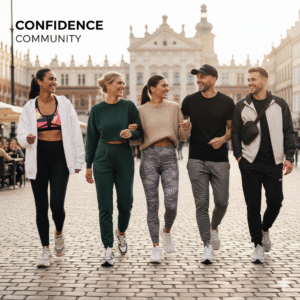
Activewear has come a long way—from neon windbreakers in the 80s to today’s sleek, eco-conscious athleisure that defines European street style. What started as clothing designed purely for workouts has evolved into something far greater: a lifestyle choice that blends comfort, functionality, and personal expression.
In the 21st century, fashion is no longer just about looking good—it’s about feeling good and living authentically. Activewear captures this perfectly. It allows us to move freely, dress confidently, and show up in the world in styles that reflect both our individuality and our values. Whether it’s smart fabrics that enhance performance, eco-friendly materials that protect the planet, or inclusive designs that celebrate all body types, activewear is shaping a future that is practical, stylish, and meaningful.
Most importantly, activewear gives us permission to blur the boundaries—between gym and office, work and play, fashion and function. In Europe especially, it’s not unusual to see someone wearing performance leggings to a café in Paris, sneakers to a Milanese business meeting, or a chic tracksuit on Berlin’s creative streets. It’s a global movement, but Europe has given it a cultural and fashion-forward edge.
So, what does this mean for you? It means embracing activewear with confidence. Don’t be afraid to mix performance gear with your everyday wardrobe, experiment with layering, or invest in sustainable pieces that reflect your values. Style it up with a blazer, dress it down with a hoodie, or keep it sleek and minimal—the beauty of activewear is that it’s yours to define.
💬 Call to Action:
Now it’s your turn—what’s your favorite way to style activewear? Do you swear by bold sneakers, love pairing leggings with oversized blazers, or lean toward eco-friendly brands making waves across Europe? Share your go-to looks, brands, or styling tips—we’d love to hear how you embrace the activewear lifestyle.
Because at the end of the day, activewear isn’t just a trend—it’s a mindset. A mindset that says: move freely, live boldly, and wear your confidence wherever life takes you. 💫👟



